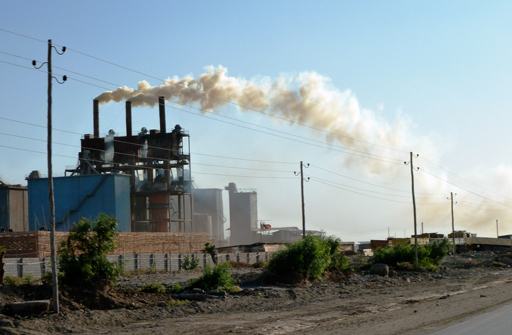Back to: BIOLOGY SS1
Welcome to class!
In today’s class, we will be talking about pollution. Enjoy the class!
Pollution

Pollution is the introduction of a contaminant into the natural environment, by humans activities. It is the release of harmful substances into the environment or the release of these harmful substances in quantities that are toxic to nature.
The substances that pollute the environment when released are called Pollutants.
Three major types of pollution are:
- Air Pollution.
- Water Pollution.
- Land Pollution.
Air pollution:
Air pollution occurs when harmful or excessive quantities of substances are introduced into the Earth’s atmosphere. From man’s daily activities pollutants such as smoke, gasses and solids are disposes into the atmosphere. Air pollution can also be said to be the presence of a mixture of gases and solid patches in the air.

The six major types of air pollutants are:
- carbon monoxide,
- hydrocarbons,
- nitrogen oxides
- particulates (dust particles)
- sulphur dioxide and 6).photochemical oxidants.
Sources of air pollution include
- Vehicle or manufacturing exhaust
- Forest fires, volcanic eruptions, dry soil erosion, and other natural sources
- Building construction or demolition
- Noise/sound from blaring of loudspeakers.
Air pollution affects man and his resources in various ways, such as:
- Some air pollutants irritate the eyes in humans
- Carbon (ii) oxide can easily combine with haemoglobin that can reduce the oxygen-carrying capacity of the blood.
- Smoke particles make streets and building dirty.
- Smoke reduces visibility within the environment.
- Smoke smog and dust can reduce the intensity and quality of sunlight which in turn reduces photosynthesis and automatically crop yields.
- Nitrogen oxides in very high concentration can cause the death of animals.
- Sulphur (iv) oxide a pollutant resulting from the activities of petroleum refineries, poisons plant and lower their yield.
- Sulphur (iv) oxide causes respiratory diseases as it damages respiratory organs.
- It makes the soil highly acidic as it forms tetraoxosulphate (iv) acid in rainwater and affects plant growth negatively.
- Dust particles in the atmosphere reduce visibility and intensity of sunlight, dust in water spoil its quality for drinking.
- Pollen grains present in dust trigger off bouts of lung disorders such as asthma.
- Smog reduces visibility, hours of sunlight and could be dangerous for motorists.
Control of air pollution
- The government should regulate the activities of some industries.
- Citizens should be educated on the harmful effects of pollution.
- Industries should be sited for away from residential and commercial areas.
- Chimney pieces should be used in houses, industries and similar places to release their pollutants for from ground level.
Water pollution:
Water pollution is the process whereby harmful waste materials are deposited into water bodies making them unfit for aquatic life and human consumption.
Water bodies such as estuaries, rivers, streams, lakes and seas get polluted when diverse materials and toxic wastes from domestic and industrial activities of man are dumped into them. Rainwater also gets polluted as carbon (iv)oxide from the air get dissolve into it.

Types of water pollution
- Refuse and sewage.
- Industrial waste.
- Excess and waste from herbicides, pesticides, insecticides and fertilizers
- Crude oil spillage
Effects of water pollution
- Water bodies are contaminated making water unfit for consumption and unsafe for aquatic organisms.
- Results in loss of natural habitat for some organisms.
- Results in death of some organisms
- Oil spillage can cripple economic life of fisherman and farmers in affected areas.
- The spilled oil forms a coat on the surface of the water cutting off oxygen.
- When oxygen is cut off, it results in the death of organisms leading to eutrophication.
Control of water pollution
- Refuse and sewage should be treated and efficiently disposed of.
- Enlightenment of public on proper disposal of human faeces, wine and domestic refuse.
- Indiscriminate dumping of industrial wastes in water bodies should be avoided. Recycling of industrial effluents should be encouraged.
- Farmers should be educated on the proper use of fertilizers, pesticides, insecticides and herbicides.
- All necessary precautions should be taken to avoid oil spillage.
Land pollution:
Land Pollution refers to the deterioration of the earth’s land surfaces. Furthermore, it occurs mainly due to the indirect and direct effects of human activities. Similarly, when we misuse the land resources, land pollution happens. Land pollution occurs when there is a deposition of solid or liquid waste materials on land or underground in a manner that can contaminate the soil and groundwater.

Land pollutants
- Sewage waste from homes and factories
- Refuse waste and other dry wastes
- Agricultural wastes
- Wood and metal objects
- Waste from refineries
Causes of land Pollution
- Indiscriminate dumping of refuse and sewage
- Deforestation
- Excessive use of fertilizer and other agricultural products.
- Crude oil spillage and pipe leakage.
Effects of land Pollution
- Groundwater can be contaminated through leaching.
- The environment will be unsightly.
- Land and valuable space can be overtaken by refuse.
- Indiscriminate sewage dumped can produce an offensive odour.
In our next class, we will be talking about the Conservation of Natural Resources. We hope you enjoyed the class.
Should you have any further question, feel free to ask in the comment section below and trust us to respond as soon as possible.

This class is very interesting.
I love this